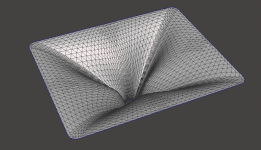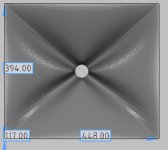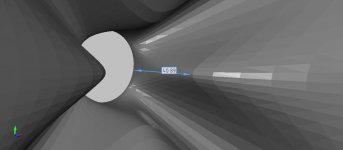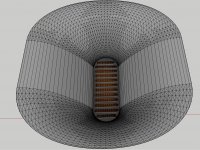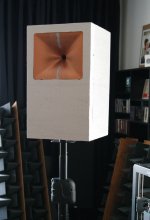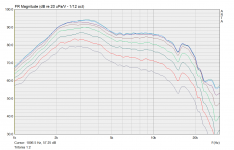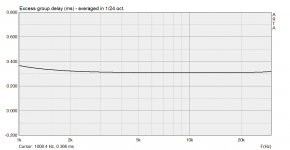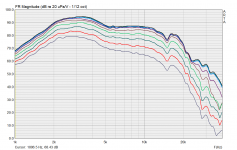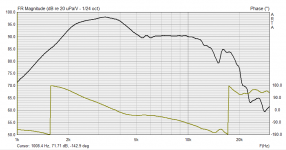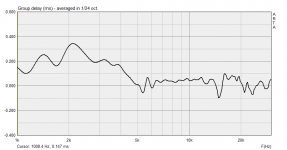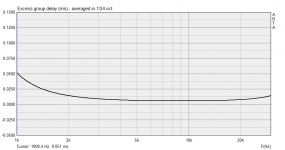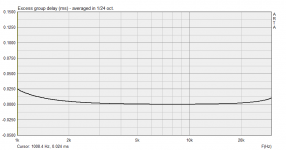What's (subjectively) considered to be good also remains a matter of personal preference. In Europe, numerous horn adepts still prefer this almost 25 year old 1" horn to modern waveguides like QSC / B52, JBL, Pi (Wayne Parham), SEOS etc.
Which horn is this?
Br
Gisle
Yeah, there was a silly bug. It's fixed now: https://at-horns.eu/release/ath-4.7.1-beta2-32bit.zipI got the same effect of clipped corners when I tried to make a more highly asymmetric waveguide recently when someone was asking for one.
Attachments
"A matter of personal preference", I guess.
Perhaps a lack of engineering knowledge, or even a deliberate decision.
Have you ever tested the H100?
Last edited:
Yeah, there was a silly bug. It's fixed now: https://at-horns.eu/release/ath-4.7.1-beta2-32bit.zip
Yes, thank you very much for that, my corners are also much better now. This time I have forced the M2 dimensions along with a 38mm throat and 40mm knuckles, to the best of my abilities. The superformula butterfly shape doesn't seem to be very forgiving. It was a good exercise though.
After getting to know more about the M2 horn and its trickery, I am beginning to think that the 2352 is a much better choice, considering its depth and loading abilities. Afterall, the M2 horn is just a 40mm tube followed by a rather shallow profile, that maybe alright for use above 1.5kHz or so. I also feel that it may be possible to smooth out the 2352 flare rate around its "already not very intrusive diffraction slot", without losing much.
Attachments
Last edited:
JBL M2
Also, if the M2 system from JBL sounds really nice, the magic is most likely to be within the D2 driver, rather than the horn. Just what I think.
Also, if the M2 system from JBL sounds really nice, the magic is most likely to be within the D2 driver, rather than the horn. Just what I think.
Horn for AMT with ath4
I am trying to create a horn for Mundorf AMT25CS2.1-R with ath4.
Therefor I will set the throat size to 34mm, because that´s the diagraph width of the AMT. Then I will just cut the exported STL in the middle, and move it away by the diagraph length and just connect the two horn segments with each other (see attached sketchup-screenshot).
To simulate the horizontal dispersion. Can I assume that a round 34mm driver will do the same as a long vertical diagraph which is also 34mm wide (like this AMT)? If only the diagraph width matters it should be or?
For sure the vertical dispersion cannot bet simulated because of the complete differnt diagraph length. In this case which exit angle you would use for generating the contour? Physically it should be "0" but as I have seen on most AMT horns/waveguides they already starting at a angle of about 30 degrees and up.
Would be cool to get some suggestions how to proceed here.
I am trying to create a horn for Mundorf AMT25CS2.1-R with ath4.
Therefor I will set the throat size to 34mm, because that´s the diagraph width of the AMT. Then I will just cut the exported STL in the middle, and move it away by the diagraph length and just connect the two horn segments with each other (see attached sketchup-screenshot).
To simulate the horizontal dispersion. Can I assume that a round 34mm driver will do the same as a long vertical diagraph which is also 34mm wide (like this AMT)? If only the diagraph width matters it should be or?
For sure the vertical dispersion cannot bet simulated because of the complete differnt diagraph length. In this case which exit angle you would use for generating the contour? Physically it should be "0" but as I have seen on most AMT horns/waveguides they already starting at a angle of about 30 degrees and up.
Would be cool to get some suggestions how to proceed here.
Attachments
Now, it's difficult to blame people for that because our rooms, halls, theatres, cars, buildings, streets are all rectangular. Only the speakers and their diaphragms / cones are circular. This is also why you're a considered an "out of the ordinary" fellow if you have a circular / spherical office whereas your mate who has a rectangular one is not.
Wow, this logic certainly changes my mind. But wait, the sun is round, so does that change anything?
After getting to know more about the M2 horn and its trickery, I am beginning to think that the 2352 is a much better choice, considering its depth and loading abilities. Afterall, the M2 horn is just a 40mm tube followed by a rather shallow profile, that maybe alright for use above 1.5kHz or so. I also feel that it may be possible to smooth out the 2352 flare rate around its "already not very intrusive diffraction slot", without losing much.
Also, if the M2 system from JBL sounds really nice, the magic is most likely to be within the D2 driver, rather than the horn. Just what I think.
In the past I came to similar conclusions, especially wrt to the 2352.
The M2's main benefits (and design objectives) are related to the wide coverage angles and smooth off-axis response.
Interesting features of the D2430K are notably the dual annular diaphragms that operate in tandem, and (possibly) the phase plug channels.
However, I'm not convinced these attributes justify the rather steep price.
Interesting question: what would it take to have the M2 beat the Revel Ultra Salon2 in listening tests?
Imo directivity is (almost) irrelevant in this contest as both are champs in this respect.
I believe the public preference (😉) for the Salon is much more related to driver characteristics and their integration into the system.
Last edited:
I quite believe it's only a matter of EQ "fine tuning" in this particular case.what would it take to have the M2 beat the Revel Ultra Salon2 in listening tests?
First quick measurement of the Tritonia model (~1:2 with B&C DE7, 0 - 90 deg) - horizontal polars:

I will measure all the polars properly and then try to round the edges. There seems not much to improve so I'm curious what will be the difference.
I will measure all the polars properly and then try to round the edges. There seems not much to improve so I'm curious what will be the difference.
Attachments
2 quotes taken from ASR:
"Of course, I take some of the comments with a grain of salt. The same guy who said the M2 was aggressive also said it wasn't as dynamic sounding as the Revel."
Amir (Revel owner): "I agree. The M2's DNA is to be dynamic and it is. We have it in our theater at work and it peels the skin of your face with no distortion!"
Is this all?
A handle of a general nature:
Just zooming in without understanding the (zoomed out) context - or, seeing the bigger picture - and the underlying, interdependent mechanisms, is pretty much useless.
(Also consider the current situation in this world 😉)
"Of course, I take some of the comments with a grain of salt. The same guy who said the M2 was aggressive also said it wasn't as dynamic sounding as the Revel."
Amir (Revel owner): "I agree. The M2's DNA is to be dynamic and it is. We have it in our theater at work and it peels the skin of your face with no distortion!"
Is this all?
A handle of a general nature:
Just zooming in without understanding the (zoomed out) context - or, seeing the bigger picture - and the underlying, interdependent mechanisms, is pretty much useless.
(Also consider the current situation in this world 😉)
Last edited:
I quite believe it's only a matter of EQ "fine tuning" in this particular case.
Applying more EQ to a system that has already been eq-ed to the max?
M2 may well be "too flat" when directly compared with the Revel (i.e. without any in-situ tweaking). That would be my guess.
Last edited:
Measured excess group delay at some arbitrary off-axis angle 🙂
That doesn't look right to me, basically because it is still above 0.0, meaning that there is still an excess of delay of about .3 ms.
Could you post the frequency response that this corresponds to? If this is a near "ideal" device then maybe this is what I would expect. Now, what does a non-ideal device look like?
2 quotes taken from ASR:
"Of course, I take some of the comments with a grain of salt. The same guy who said the M2 was aggressive also said it wasn't as dynamic sounding as the Revel."
Amir (Revel owner): "I agree. The M2's DNA is to be dynamic and it is. We have it in our theater at work and it peels the skin of your face with no distortion!"
Is this all?
A handle of a general nature:
Just zooming in without understanding the (zoomed out) context - or, seeing the bigger picture - and the underlying, interdependent mechanisms, is pretty much useless.
(Also consider the current situation in this world 😉)
FWIW, I'm an M2 owner and really tried to like the S2 but they're too "hifi" to me. The M2 has a very special way of being non forgiving and that's what I wanted as before with the GedLee Abbey.
Yes, there's still some uncompensated propagation delay, I just arbitrarily chose the FFT window beginning. Here it is better compensated (may require sub-sample precision to compensate perfectly - probably also possible with ARTA, I'm just re-learning the program).That doesn't look right to me, basically because it is still above 0.0, meaning that there is still an excess of delay of about .3 ms.
Frequency response:
Group delay:
Excess group delay:
(I believe the rise on the sides is due to the minimum phase extraction.)
I will have to look for such a device, maybe I will find something in the cellar 🙂Now, what does a non-ideal device look like?
Attachments
- Home
- Loudspeakers
- Multi-Way
- Acoustic Horn Design – The Easy Way (Ath4)
